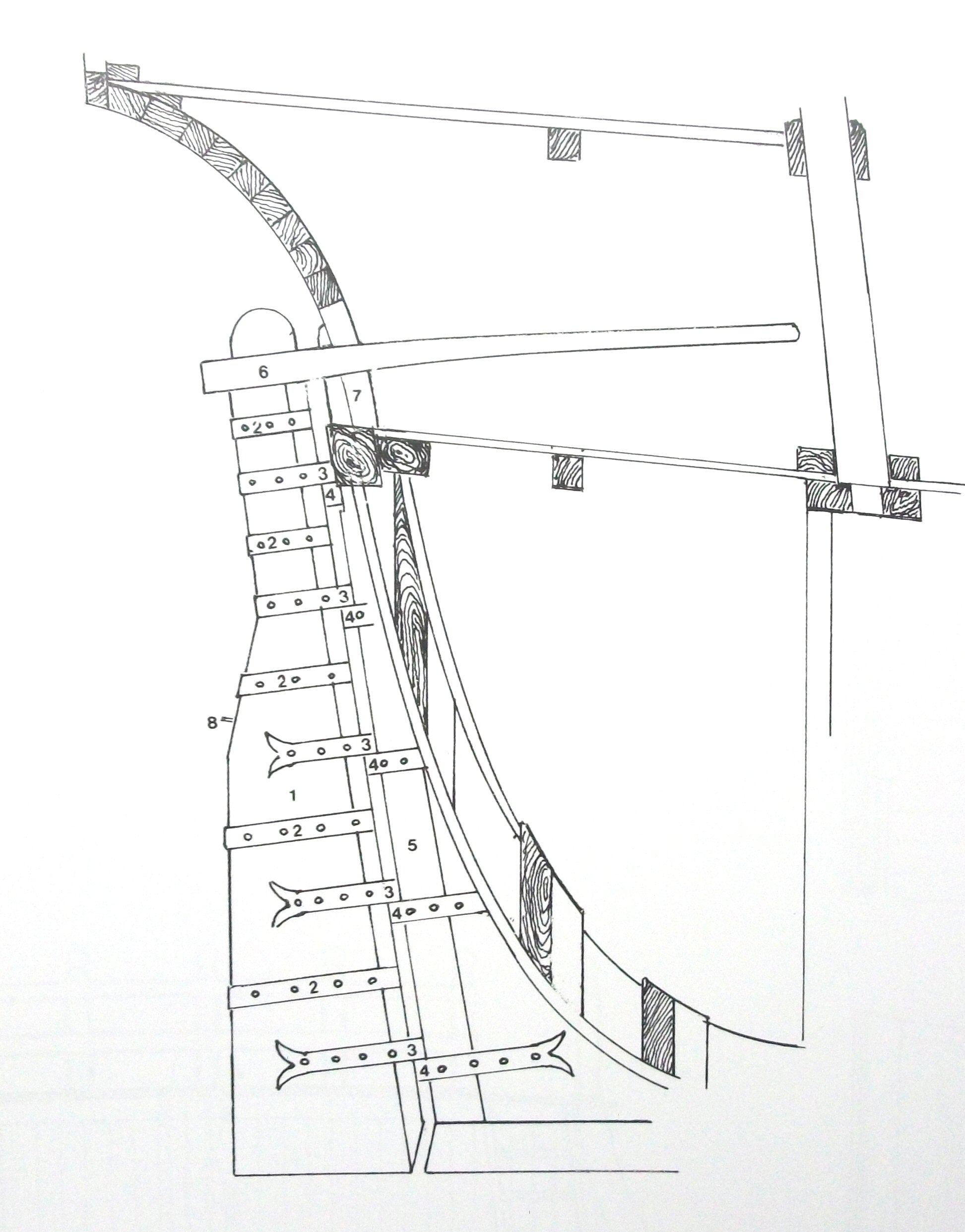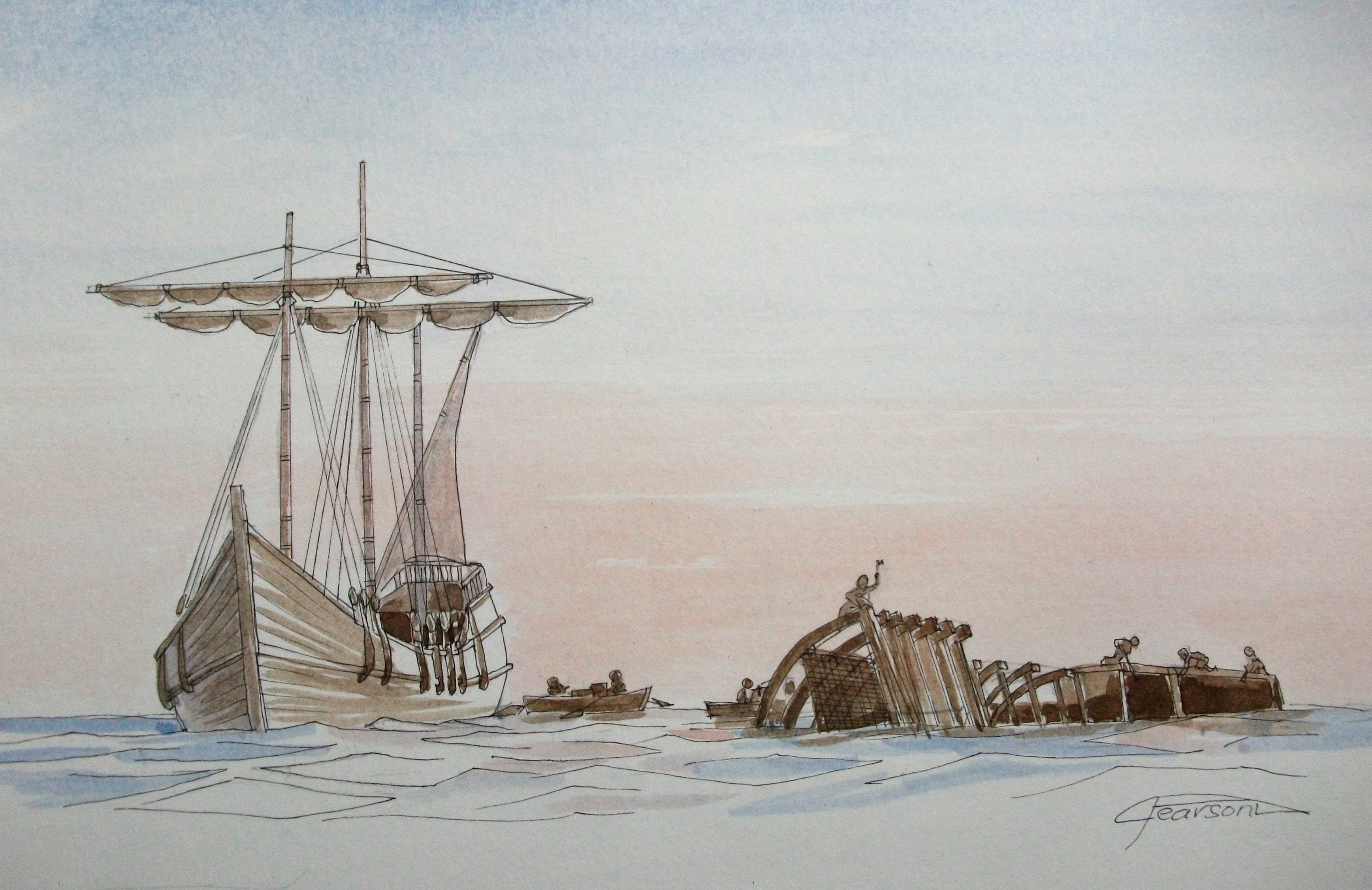By the 25th according to his log, Columbus had not slept for 48 hours. The coast here was full of sandbanks or rocks, and to approach the shore was dangerous. This is where there is some controversy over what is recorded in the log. The Captain of the Santa Maria was Juan de la Cosa, but throughout the exploration of the islands and accounts of meeting the natives, Juan de la Cosa is never mentioned. As captain, de la Cosa would not have to stand watches, he had capable crewman who understood the complexities of sailing his boat. There was a hierarchy of trusted and proven friends which had been built up over a number of years. It was essential that a seagoing ship should have men who could be trusted to sail the ship safely whilst others slept. So why was Columbus having to stay awake?
Both ships were in a bay that Columbus had explored the previous Sunday from the rowing boat that was stored on deck and used to go ashore. There was an open passage that extended from deep water to the beach, but bounded on both sides by sandbanks and reefs. There was no wind, and the sea state was described as in a "porringer”, (bowl) or calm. According to what was written in the log, at eleven o’clock in the evening the admiral went to his bunk to sleep, leaving a sailor at the helm. The rest of the crew also were sleeping when the sailor on watch handed the helm to the cabin boy and went to his own bunk.
Let me show you what the helm of the Santa Maria looked like.

This is not the wheel with handles and ropes that turned the rudder in bigger ships. The rudder of the Santa Maria probably weighed well over a hundred kilos and was operated by a ten foot tiller. It was operated from two decks below the stern forecastle, where the captain had an unrestricted view of the ship and its surroundings. Between the two decks was the captain’s cabin. To steer the ship required at least two people, one on the stern forecastle who could see where they were going, and the other, two decks below to push the rudder in the required direction. To imagine that a ten-year-old boy could control the ship alone, even in a dead calm, is folly. But at night, when there are no lookouts, is criminal. Something was badly wrong. Where was the chain of command? Where were the leading officers who had spent years at sea and knew the rules and risks.
The poor cabin boy raises the alarm as the ship gently runs aground on a sandbank. In the near distance is the sound of breaking waves on a reef or shore. Columbus feels the change in the motion of the ship and immediately wakes from his sleep and runs up to the forecastle to take command. Columbus’ log then says that the master of the watch came out, and Columbus orders him to launch the rowing boat and take an anchor and cast it at a distance from the stern of the Maria. The anchor line would then be put around the capstan and the crew could wind the Maria off the sandbank.
Who “the master of the watch” was is not clear, but it has to be Juan de la Cosa.
Columbus does not mention him by name in his logs, but other later accounts say that a blazing row developed on what to do next. De la Cosa would be pretty upset that his ship had been allowed to run aground, but seemingly he insists that they must abandon ship and go to the Niña, which was “half a league to windward”. Columbus accuses him of treason and desertion in the face of danger, serious charges for which others have received the death penalty. Judging by the language in the log you would expect some sort of court martial or attempted court martial at home afterward, but no such thing is recorded, and Juan de la Cosa is never mentioned by name. Nevertheless, the boat is launched, but the men in the boat led by the “master” rowed to the Niña.
The captain of the Niña rightly refused to allow them aboard and ordered them to return to the Maria. All this must have taken a couple of hours, meanwhile the tide was falling, and the pressure on the Maria’s hull was focused on one point, and the hull timbers were bending. If the caulking between the hull planks gave way, the sea would flood in. Columbus ordered that the mast be cut down and all excess weight be thrown overboard to lighten the ship and re-float her. There was no terrible storm, just the inexorable retreat of the ocean, and finally, the hull planks gave way between the ribs, and the sea filled the hold of the Santa Maria. Columbus could not save his flagship; it was too far from the shore for the crew to swim, and so they were ferried to the Niña in the rowing boat. The Niña spent the rest of the night using whatever wind there was to stay away from shallow water. At dawn, the small boat set out for the shore with Diego de Arana, of Cordoba, Alguacil of the fleet, and Pedro Gutierrez, "repostero" of the Royal House, to find the Cacique who had invited Columbus to bring his ships to his harbour the previous Saturday.
When the Spanish dignitaries explained what had happened to the Cacique he wept. Within an hour he had organised the people of the village to take “many large canoes” and help Columbus unload the Maria and salvage whatever they could. In his log Columbus says that they unloaded the Maria with great assiduity and ensured that whatever was unloaded and carried to the shore was done so without pilfering. The Cacique set aside several houses in which to store any valuables and placed guards around them at night. The whole village was openly distraught at the plight of the Spanish. Columbus is moved enough to write in the notes that he intends to show Queen Isabel and King Fernando that:
“They are an affectionate people and free from avarice and agreeable in everything, and I certify to your Highnesses that in all the world I do not believe there is a better people or a better country: they love their neighbours as themselves and they have the softest and gentlest speech in the world and are always laughing. They go naked, men and women, as their mothers gave them birth. But your Highnesses may believe that they have very good customs among themselves and the King maintains a most wonderful state, and everything takes place in such an appropriate and well-ordered manner that it is a pleasure to see it all.”
Natives began to arrive in their canoes from further up the coast bringing gold, which they were more than willing to trade for hawk’s bells. The Cacique invited Columbus to eat with him, and he writes that he was very impressed with the king’s table manners and cleanliness, and that after eating they rubbed their hands with certain leaves to clean them. Columbus gave the king a shirt and gloves which impressed him so much that he wore them continuously, and after the meal Columbus gave a display of a Turkish bow and arrow that he had ordered brought form the Niña. The natives had no knowledge of the weapon, and were impressed with the iron arrowhead. Columbus was quick to note that they had never seen iron or copper before, and the steel of their swords was a source of constant amazement.

Painting: Alan Pearson. alanpearson.pixels.com
It was obvious to all that they could not all go back to Spain on the Niña, and Columbus ordered that the Maria be cut up to build a stockade near the native village where he can store the weapons and cannons so that they don’t fall into the hands of the natives. Half the crew of the Santa Maria dismembered their ship and floated all the timber to the beach. They left the hull where it was, but everything else was brought ashore where the other half of the crew were building the stockade which Columbus named Fort Navidad. He writes: “And it is quite true that many of the people who are here have begged me that I would give them permission to remain. Now I have ordered a tower and fortress constructed and all in a very good manner and a large cellar.”
But in in his private log, Columbus bleakly writes:
“Had it not been for the treachery of the Master and of the people, who were all or most of them from his country, in not wishing to cast the anchor at the stern to draw the ship off as the Admiral ordered them to do, that the ship would have been saved.” He continues, “And the taking of such a ship he says was due to the people of Palos, who did not fulfil what the King and Queen had promised him, that is that he should he given ships suitable for that journey, and they did not do it.”
He discharges his culpability in the loss of the Santa Maria with the words “of all there was in the ship not a leather strap was lost, nor a board nor a nail, because the ship remained as sound as when she started except that she was chopped and split some in order to take out the butts and all the merchandise.”
But the real problem was still there in the form of a crew that constantly disobeyed his orders, and a little later in his diary he fumes: “I will not suffer the deeds of evil-disposed persons, with little worth, who, without respect for him to whom they owe their positions, presume to set up their own wills with little ceremony.”
Much of the cargo that he wanted to take back to Castile had been loaded onto the Niña, and now he had to choose who was to be left behind. The only blessing that Columbus could count on was the generosity of the natives in helping him deal with the loss of his flagship. They had promised to “cover him in gold” before his departure.
But gold is the colour of greed and treachery. Facing him now was the very frightening prospect of crossing the Atlantic with a mutinous crew who knew where the New World and its gold was, could speak its language and did not need this jumped-up “Admiral of the Ocean” to take all the glory.